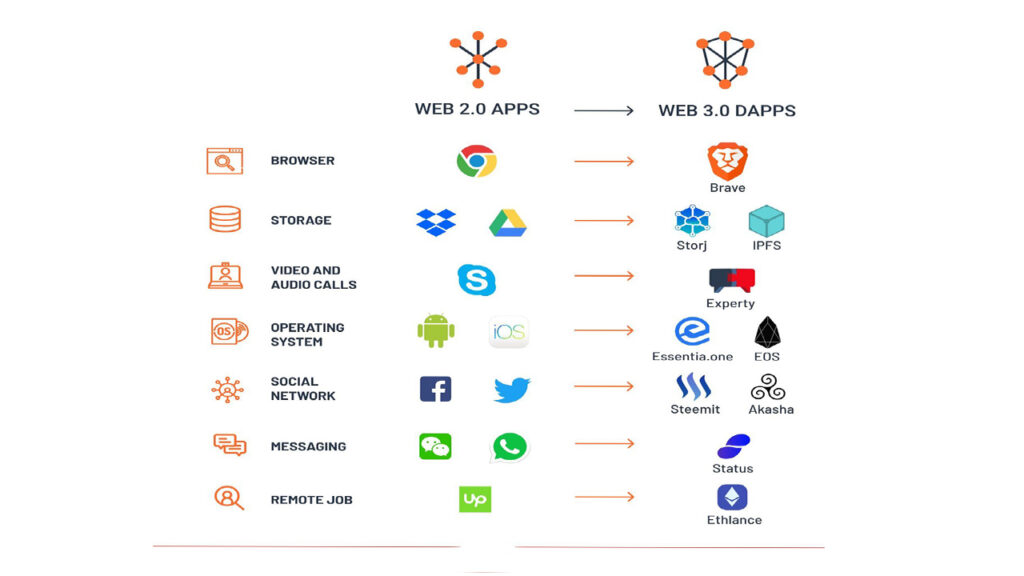
Imagine a new type of internet that not only accurately interprets what you input, but actually understands everything you convey, whether through text, voice or other media, one where all content you consume is more tailored to you than ever before.
One that gives you full privacy controls over the data you share with other parties, allows you to earn money if you provide it to advertisers or interact with certain applications, and remains free from draconian third-party censorship.
What is Web 3.0?
The movement aims to create open, connected, intelligent websites and web apps with an improved machine-based understanding of data. Decentralization and digital economies also play an important role in Web 3.0, as they allow us to place value on the content created on the net. It’s also important to understand that Web 3.0 is a changing concept. There is no single definition, and its exact meaning can differ from person to person.
At present, Web3 is still a rather undefined concept that could take 5-10 years to build if we look at the transition from Web2 to Web3. In fact, we might very well first see a prolonged era of Web2.5, where Web2 platforms gradually onboard useful Web3 protocols.
There is broad consensus amongst experts that blockchain-powered applications will be key to its success in order to ensure adequate decentralization, while AI and ML tools will help automate and scale it as required in order to become a semantic web.
Web3 was in fact originally called the Semantic Web by World Wide Web inventor Tim Berners-Lee, and was aimed at being a more autonomous, intelligent, and open internet.
How does Web 3.0 work?
Current websites typically display static information or user-driven content, like forums or social media. While this allows data to be published to the masses, it doesn’t cater to specific users’ needs. A website should tailor the information it provides to each user, similar to the dynamism of real-world human communication. With Web 2.0, once this information is online, users lose ownership and control.
Main differences between Web 1.0, 2.0, and 3.0 are as follows:
|
Web 1.0 |
Web 2.0 |
Web 3.0 |
|
|
Content |
Passive interaction for the user |
Community platforms and user-generated content |
User-ownership for content creators |
|
Technologies |
HTML was used only |
Dynamic HTML, Java Script, |
Blockchain, AI, machine learning |
|
Virtual environments |
None |
Some basic 3D use |
3D, VR, AR |
|
Advertising |
Obtrusive (banners, etc.) |
Interactive advertising |
Targeted based on user behavior |
|
Data storage |
Stored on individual websites’ servers |
Owned by large tech giants |
Distributed across users |
|
Audience |
Individual users |
Specific communities of users |
Interconnected users across multiple platforms and devices |

Key Features of Web3.0
To really understand the next stage of the internet, we need to take a look at the 5 key features of Web3:
- Ubiquity
- Semantic Web
- Artificial Intelligence
- Spatial Web and 3D Graphics
- Decentralization through blockchain
Ubiquity
Ubiquity means being or having the capacity to be everywhere, especially at the same time. In other words, omnipresent. In that sense, Web 2.0 is already ubiquitous since, for instance, a Facebook user can instantly capture an image and share it, which then becomes ubiquitous since it’s available to anyone no matter where they are, as long as they have access to the social media platform.
Web3 simply takes this a step further by making the internet accessible to everyone anywhere, at any time. At some point, internet-connected devices will no longer be concentrated on computers and smartphones like in Web 2.0 since IoT (Internet of Things) technology will bring forth a plethora of new types of smart devices.
Semantic Web
Semantic(s) is the study of the relationship between words. Therefore, the Semantic Web, according to Berners-Lee, enables computers to analyze loads of data from the Web, which includes content, transactions and links between persons. In practice, how would this look? Let’s take these two sentences, for instance:
1. I love Bitcoin
2. I <3 Bitcoin
Their syntax may be different, but their semantics are pretty much the same, since semantics only deals with the meaning or emotion of the content.
Applying semantics in the Web would enable machines to decode meaning and emotions by analyzing data. Consequently, internet users will have a better experience driven by enhanced data connectivity.
Artificial Intelligence
Wikipedia defines AI as intelligence demonstrated by machines.
And since Web3 machines can read and decipher the meaning and emotions conveyed by a set of data, it brings forth intelligent machines. Although Web 2.0 presents similar capabilities, it is still predominantly human-based, which opens up room for corrupt behaviors such as biased product reviews, rigged ratings, etc.
For instance, online review platforms like Trustpilot provide a way for consumers to review any product or service. Unfortunately, a company can simply gather a large group of people and pay them to create positive reviews for its undeserving products. Therefore, the internet needs AI to learn how to distinguish the genuine from the fake in order to provide reliable data.
Google’s AI system recently removed around 100,000 negative reviews of the Robinhood app from the Play Store following the Gamespot trading debacle when it detected attempts of rating manipulation intended to artificially downvote the app. This is AI in action, which will soon seamlessly fit into Internet 3.0, enabling blogs and other online platforms to sift data and tailor them to each user’s liking. As AI advances, it will ultimately be able to provide users with the best filtered and unbiased data possible.
Spatial Web and 3D Graphics
Some futurists also call Web3 the Spatial Web as it aims to blur the line between the physical and the digital by revolutionizing graphics technology, bringing into clear focus three-dimensional (3D) virtual worlds.
Decentralization and Blockchain
Blockchain and crypto technology have enjoyed a huge rise in popularity in the last decade due to their ability to globally facilitate the decentralized transfer of data and value in a fully trustless, transparent and immutable manner. This makes it ideal for an internet that must be able to protect the privacy of information and resist attempts at censorship or sabotage by third-parties.
While crypto in particular have in the past struggled to deliver a compelling use case beyond being digital gold of some kind, the subsequent rise in DeFi, NFTs and now Web3 now offer a clear roadmap to a future digital economy.

Applications of Web3.0
A common requirement for a Web3 application is the ability to digest large-scale information and turn it into factual knowledge and useful executions for users. With that being said, these applications are still at their early stages, which means that they have a lot of room for improvement and are a far cry from how Web3 apps could potentially function.
Some of the companies that are building or have products that they are transforming into Internet 3.0 applications are Amazon, Apple and Google. Three examples of applications that utilize Web3 technologies are Siri, Wolfram Alpha and Brave Browser.
Siri
Over the years, Apple’s voice-controlled AI assistant has grown more intelligent and has expanded its abilities since its first appearance in the iPhone 4S model. Siri uses speech recognition and artificial intelligence, a key component of Web3, to be able to perform complex and personalized commands.
Wolfram Alpha
Wolfram Alpha is a “computational knowledge engine” that answers your questions directly by computation, as opposed to giving you a list of webpages like search engines do. If you want a practical comparison, search “england vs brazil” on both Wolfram Alpha and Google and see the difference.
Brave Browser
Current web2 browsers like Chrome are very popular and offer additional functionality through a large library of custom extensions that often cross over into the crypto realm, such as wallet extensions by the likes of MetaMask, Phantom and others. However, it’s also easy for bad actors to create counterfeit or tweaked versions of these applications, attract potential victims through phishing techniques, and fool them into providing wallet access or sending their crypto to a hacker or scammer’s address.
Connected smart homes
One key feature of Web 3.0 is ubiquity. This means that we can access our data and online services across multiple devices. Systems that control your home’s heating, air conditioning, and other utilities can now do so in a smart and connected manner. Your smart home can tell when you leave, arrive, and how hot or cold you like your house. It can use this information, and more, to create a personalized experience. You can then access this service from your phone or other online devices, no matter where you are.





